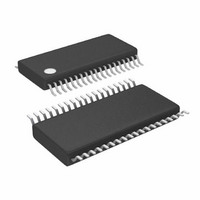LTC3865IFE#PBF Linear Technology, LTC3865IFE#PBF Datasheet - Page 30

LTC3865IFE#PBF
Manufacturer Part Number
LTC3865IFE#PBF
Description
IC BUCK SYNC ADJ DUAL 38TSSOP
Manufacturer
Linear Technology
Type
Step-Down (Buck)r
Datasheet
1.LTC3865EUHPBF.pdf
(38 pages)
Specifications of LTC3865IFE#PBF
Internal Switch(s)
No
Synchronous Rectifier
Yes
Number Of Outputs
2
Voltage - Output
0.6 ~ 5 V
Frequency - Switching
250kHz ~ 770kHz
Voltage - Input
4.5 ~ 38 V
Operating Temperature
-40°C ~ 125°C
Mounting Type
Surface Mount
Package / Case
38-TSSOP Exposed Pad, 38-eTSSOP, 38-HTSSOP
Lead Free Status / RoHS Status
Lead free / RoHS Compliant
Current - Output
-
Power - Output
-
Available stocks
Company
Part Number
Manufacturer
Quantity
Price
APPLICATIONS INFORMATION
LTC3865/LTC3865-1
6. Keep the switching nodes (SW1, SW2), top gate nodes
7. Use a modifi ed “star ground” technique: a low imped-
PC Board Layout Debugging
Start with one controller at a time. It is helpful to use a
DC-50MHz current probe to monitor the current in the
inductor while testing the circuit. Monitor the output
switching node (SW pin) to synchronize the oscilloscope
to the internal oscillator and probe the actual output
voltage as well. Check for proper performance over the
operating voltage and current range expected in the
application. The frequency of operation should be main-
tained over the input voltage range down to dropout and
until the output load drops below the low current opera-
tion threshold—typically 10% of the maximum designed
current level in Burst Mode operation.
The duty cycle percentage should be maintained from
cycle to cycle in a well-designed, low noise PCB
implementation. Variation in the duty cycle at a
30
(TG1, TG2), and boost nodes (BOOST1, BOOST2) away
from sensitive small-signal nodes, especially from the
opposite channel’s voltage and current sensing feed-
back pins. All of these nodes have very large and fast
moving signals and therefore should be kept on the
“output side” of the LTC3865/LTC3865-1 and occupy
minimum PC trace area. If DCR sensing is used, place
the top resistor (Figure 2b, R1) close to the switching
node.
ance, large copper area central grounding point on
the same side of the PC board as the input and output
capacitors with tie-ins for the bottom of the INTV
decoupling capacitor, the bottom of the voltage feedback
resistive divider and the SGND pin of the IC.
CC
subharmonic rate can suggest noise pickup at the current
or voltage sensing inputs or inadequate loop compensation.
Overcompensation of the loop can be used to tame a
poor PC layout if regulator bandwidth optimization is
not required. Only after each controller is checked for
its individual performance should both controllers be
turned on at the same time. A particularly diffi cult region
of operation is when one controller channel is nearing its
current comparator trip point when the other channel is
turning on its top MOSFET. This occurs around 50% duty
cycle on either channel due to the phasing of the internal
clocks and may cause minor duty cycle jitter.
Reduce V
of the regulator in dropout. Check the operation of the
undervoltage lockout circuit by further lowering V
monitoring the outputs to verify operation.
Investigate whether any problems exist only at higher
output currents or only at higher input voltages. If problems
coincide with high input voltages and low output currents,
look for capacitive coupling between the BOOST, SW, TG,
and possibly BG connections and the sensitive voltage
and current pins. The capacitor placed across the current
sensing pins needs to be placed immediately adjacent to
the pins of the IC. This capacitor helps to minimize the
effects of differential noise injection due to high frequency
capacitive coupling. If problems are encountered with
high current output loading at lower input voltages, look
for inductive coupling between C
MOSFET components to the sensitive current and voltage
sensing traces. In addition, investigate common ground
path voltage pickup between these components and the
SGND pin of the IC.
IN
from its nominal level to verify operation
IN
, Schottky and the top
IN
while
3865fb













